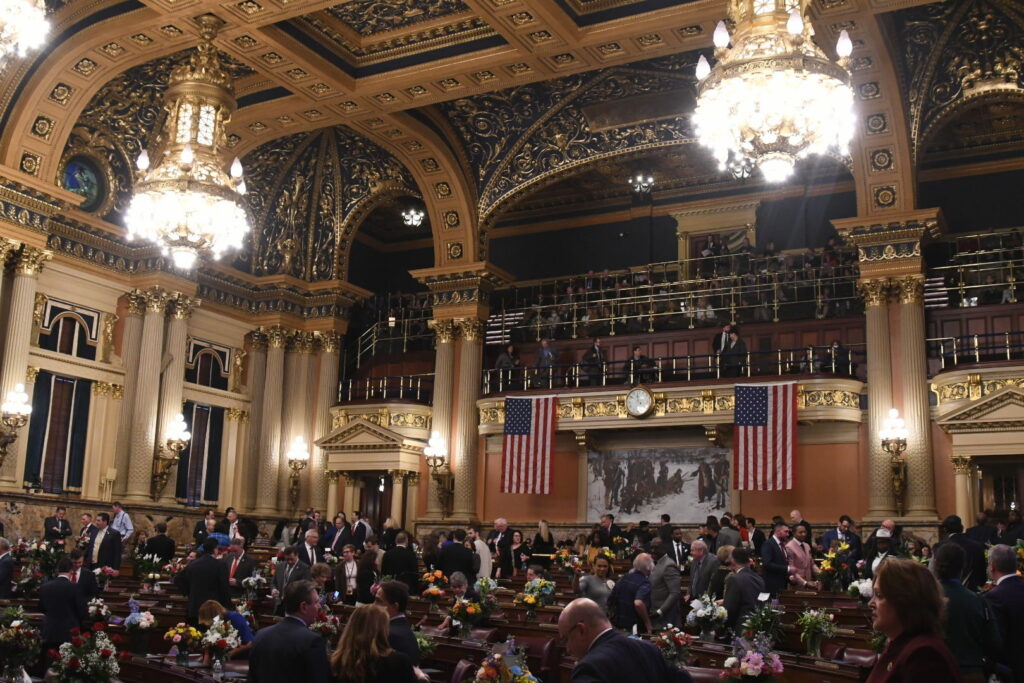
The Pennsylvania House chamber. (Capital-Star photo by Peter Hall)
Control of the Pennsylvania House of Representatives appeared to hang on the results of a single race in Cambria County, where a voting system malfunction caused election day chaos and caused the vote count to drag into Wednesday afternoon.
While the Associated Press had not called the winner in eight state House races at noon on Wednesday, Democrats were focused on three particularly close districts.
By mid-afternoon, House Majority Leader Matt Bradford (D-Montgomery) said the party was confident of victory in all but one: the race between incumbent Rep. Frank Burns (D-Cambria) and his Republican challenger Amy Bradley, who was backed by GOP mega donor Jeff Yass.
“The only thing in dispute is the Cambria County Frank Burns protect,” Bradford told the Capital-Star on Wednesday.
Democrats in the other two close races claimed victory on Wednesday afternoon, although the Associated Press still had not called the races. Incumbent Rep. Brian Munroe (D-Bucks) held a 2.5% lead over Republican Daniel McPhillips. Democrat Sean Dougherty had a nearly 2% lead over Republican Aziz Gill in the northeast Philadelphia district where Democratic Rep. Kevin Boyle lost a primary challenge this year amid personal issues.


Bradford said Democrats were watching closely as Cambria County officials worked to recover from a cascade of election problems on Tuesday.
“Admittedly it’s not been great. It has been far from great. We have to ensure that every voter’s actual intent is registered,” Bradford said. “The failure of the commissioners to ensure such a process is not only disheartening, it is disconcerting.”
Cambria County election results showed Burns leading with 57% of the vote Wednesday afternoon but it was unclear how many ballots remained to be counted.
Cambria County President Commissioner Scott Hunt said in a news conference Tuesday that election officials encountered problems scanning ballots immediately after polls opened at 7 a.m.
“We initially believed that the issue was caused by a software issue. Still within the morning hours, we learned that the issue was instead caused by the ballots themselves. They were not printed correctly, and therefore the machines were not able to scan them,” Hunt said.
The Board of Elections filed a petition for emergency relief in Cambria County Court for permission to keep polls open late due to the malfunctions. President Judge Linda Rovder Fleming issued an order late Tuesday morning granting the board’s request to extend voting hours until 10 p.m. Tuesday. Any votes cast after 8 p.m. were to be cast by provisional ballot, the order said.
Meanwhile, county officials scrambled to cope with the ballot problem. In consultation with the Department of State and county solicitor, election workers were instructed to store unscanned ballots in the lockboxes where they would otherwise be stored after scanning, Solicitor Ronald Repak told the Capital-Star on Wednesday.
But after the lockboxes were full, the Board of Elections again consulted the Department of State and solicitor to authorize sheriffs’ deputies to collect the ballots and deliver them to the elections office.
A House Democratic staffer speaking on background said there are concerns remaining about the chain of custody during that process.
Pennsylvania Senate sees at least one seat flip, but Republicans maintain firm majority
Since polls closed at 8 p.m. on Tuesday, the board of elections has been working to ensure that all of the ballots are counted accurately. The votes that gave Burns his current lead reflect those from mail-in ballots, which were not affected by the scanning issue, Repak said.
The ballots that cannot be scanned, which includes all of the ballots voted before about 3 p.m. Tuesday, are being duplicated by hand by election officials with representatives of each party watching, Repak said, adding that he was uncertain how many ballots were in that category.
Repak offered no estimate of when the count would be completed.
About 2,000 ballots were cast after reprinted ballots were delivered to polling stations that can be scanned, and all of the votes cast during extended voting hours were by provisional ballots, which must be counted by a separate process, Repak said
Repak said the county performed all required testing before Election Day but did not encounter a problem with the ballots or machines until polls opened.
Burns has represented the 72nd Legislative District for 16 years and is seeking reelection to a ninth term. He is an increasingly rare rural Democrat in a county where former President Donald Trump won by about 37 points in 2020.
Bradley, a former television journalist and president of the Cambria Region Chamber, ran unopposed for the Republican nomination to challenge Burns.
Television advertising data obtained by the Capital-Star in September shows that the Commonwealth Leaders Fund, a $45 million political action committee funded largely by Montgomery County billionaire Yass, spent about $472,000 on television advertising for Bradley.
Burns’ district is one of eight Democratic-controlled districts in the state House that the Commonwealth Leaders Fund put money into. McPhillips’ most recent campaign finance report shows the PAC spent nearly $640,000 on in-kind contributions to his campaign. Bradley’s most recent campaign finance report, due Oct. 25, was not available online Wednesday.
Bradford said Wednesday that he is confident that Democrats in the state House have defeated the “red wave” that resulted in Republican victories in the state’s row offices and presidency.
“While there is still only one race to be called, it is a credit to the stewardship of the House and our Democratic governor that we have been able to do what no other legislative body has,” Bradford said, noting the chamber’s success in a divided legislature in enacting “people-centered” legislation such as child care tax credits and increased property tax and rent rebates for seniors.
YOU MAKE OUR WORK POSSIBLE.

